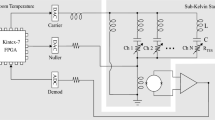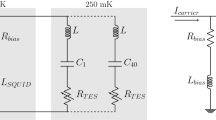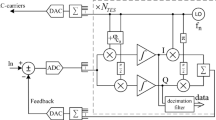Abstract
The digital frequency-domain multiplexing technique is widely used for astrophysical instruments with large detector arrays. Detailed detector characterization is required for instrument calibration and systematics control. We conduct the TES complex electrothermal-feedback response measurement with the DfMux readout system as follows. By injecting a single sideband signal, we induce modulation in TES power dissipation over a frequency range encompassing the detector response. The modulated current signal induced by TES heating effect is measured, allowing for the ETF response characterization of the detector. With the injection of an upper sideband, the TES readout current shows both an upper and a lower sideband. We model the upper and lower sideband complex ETF response and verify the model by fitting to experimental data. The model not only can fit for certain physical parameters of the detector, such as loop gain, temperature sensitivity, current sensitivity, and time constant, but also enables us to estimate the systematic effect introduced by the multiplexed readout. The method is therefore useful for in situ detector calibration and for estimating systematic effects during astronomical telescope observations, such as those performed by the upcoming LiteBIRD satellite.




Similar content being viewed by others
References
K.D. Irwin, G.C. Hilton, Transition-Edge Sensors (Springer, Cham p, 2005), p.63
D. J. Benford, The SOFIA/SAFIRE far-infrared spectrometer: highlighting submillimeter astrophysics and technology. In: Submillimeter Astrophysics and Technology: a Symposium Honoring Thomas G. Phillips, vol. 417 (2009), p. 137
R. L. Kelley et al., The X-ray microcalorimeter spectrometer for the international X-ray observatory. In: The Thirteenth International Workshop on Low Temperature Detectors - LTD13, vol. 1185 (2009), pp. 757–760
R.D. Horansky et al., Superconducting calorimetric alpha particle sensors for nuclear nonproliferation applications. Appl. Phys. Lett. 93, 123504 (2008)
R.D. Horansky et al., Analysis of nuclear material by alpha spectroscopy with a transition-edge microcalorimeter. J. Low Temp. Phys. 151, 1067–1073 (2008)
M.K. Bacrania et al., Large-area microcalorimeter detectors for ultra-high-resolution X-ray and gamma-ray spectroscopy. IEEE Trans. Nucl. Sci. 56, 2299–2302 (2009)
D. Rosenberg et al., Long-distance decoy-state quantum key distribution in optical fiber. Phys. Rev. Lett. 98, 010503 (2007)
A.J. Miller, S.W. Nam, J.M. Martinis, A.V. Sergienko, Demonstration of a low-noise near-infrared photon counter with multiphoton discrimination. Appl. Phys. Lett. 83, 791 (2003)
D. Vaccaro et al., Frequency domain multiplexing readout for large arrays of transition-edge sensors. Nucl. Instrum. Methods Phys. Res. A 1046, 167727 (2023)
A.N. Bender et al., On-sky performance of the SPT-3G frequency-domain multiplexed readout. J. Low Temp. Phys. 199, 182–191 (2020)
W. Asavanant et al., Time-domain-multiplexed measurement-based quantum operations with 25-MHz clock frequency. Phys. Rev. Appl. 16, 034005 (2021)
H. Akamatsu et al., Demonstration of MHz frequency domain multiplexing readout of 37 transition edge sensors for high-resolution X-ray imaging spectrometers. Appl. Phys. Lett. 119, 182601 (2021)
M. Dobbs et al., Multiplexed readout of CMB polarimeters. J. Phys. Conf. Ser. 155, 012004 (2009)
LiteBIRD Collaboration et al., Probing cosmic inflation with the LiteBIRD cosmic microwave background polarization survey. Prog. Theor. Exp. Phys. 2023, 042F01 (2023)
M.A. Lindeman et al., Impedance measurements and modeling of a transition-edge-sensor calorimeter. Rev. Sci. Instrum. 75, 1283–1289 (2004)
M.A. Lindeman et al., Complex impedance and equivalent bolometer analysis of a low noise bolometer for SAFARI. J. Low Temp. Phys. 167, 96–101 (2012)
Y. Zhou et al., Mapping TES temperature sensitivity and current sensitivity as a function of temperature, current, and magnetic field with IV curve and complex admittance measurements. J. Low Temp. Phys. 193, 321–327 (2018)
Y. Zhou, Towards understanding the temperature and current sensitivities of transition-edge sensors. J. Phys. Conf. Ser. 1590, 012032 (2020)
J. Martino et al., Complementary measurement of thermal architecture of NbSi TES with alpha particle and complex impedance. J. Low Temp. Phys. 176, 350–355 (2014)
Y. Takei et al., Characterization of a high-performance Ti/Au TES microcalorimeter with a Central Cu absorber. J. Low Temp. Phys. 151, 161–166 (2008)
D.J. Goldie, M.D. Audley, D.M. Glowacka, V.N. Tsaneva, S. Withington, Thermal models and noise in transition edge sensors. J. Appl. Phys. 105, 074512 (2009)
M. Galeazzi, D. McCammon, Microcalorimeter and bolometer model. J. Appl. Phys. 93, 4856–4869 (2003)
K.M. Kinnunen, M.R.J. Palosaari, I.J. Maasilta, Normal metal-superconductor decoupling as a source of thermal fluctuation noise in transition-edge sensors. J. Appl. Phys. 112, 034515 (2012)
M.R.J. Palosaari et al., Analysis of impedance and noise data of an X-ray transition-edge sensor using complex thermal models. J. Low Temp. Phys. 167, 129–134 (2012)
H. Akamatsu et al., Impedance measurement and excess-noise behavior of a Ti/Au bilayer TES calorimeter. In: The Thirteenth International Workshop on Low Temperature Detectors, vol. 1185 (2009), pp. 195–198
K.D. Irwin, An application of electrothermal feedback for high resolution cryogenic particle detection. Appl. Phys. Lett. 66, 1998–2000 (1995)
E. Taralli et al., Complex impedance of TESs under AC bias using FDM readout system. AIP Adv. 9, 045324 (2019)
T. de Haan et al., Monitoring TES loop gain in frequency multiplexed readout. JLTP, in preparation (2023)
T. de Haan et al., Recent advances in frequency-multiplexed TES readout: vastly reduced parasitics and an increase in multiplexing factor with sub-Kelvin SQUIDs. J. Low Temp. Phys. 199, 754–761 (2020)
A. Suzuki et al., Commercially fabricated antenna-coupled transition edge sensor bolometer detectors for next-generation cosmic microwave background polarimetry experiment. J. Low Temp. Phys. 199, 1158–1166 (2020)
K. Rotermund et al., Planar lithographed superconducting LC resonators for frequency-domain multiplexed readout systems. J. Low Temp. Phys. 184, 486–491 (2016)
S. T. P. Boyd, J. C. Groh, J. A. Hall, A. Suzuki, R. Cantor, Series SQUID array amplifiers optimized for MHz frequency-domain multiplexed detector readout. In: The 17th International Workshop on Low-Temperature Detectors (2017)
K. Bandura et al., ICE: a scalable, low-cost FPGA-based telescope signal processing and networking system. J. Astron. Instrum. 5, 1641005 (2016)
T. de Haan, G. Smecher, M. Dobbs, Improved performance of TES bolometers using digital feedback. Millim. Submillimeter FarInfrared Detect. Instrum. Astron. VI 8452, 84520E (2012)
B. Westbrook et al., The POLARBEAR-2 and Simons array focal plane fabrication status. J. Low Temp. Phys. 193, 758–770 (2018)
A. Suzuki, Multichroic bolometric detector architecture for cosmic microwave background polarimetry experiments. Ph.D. thesis, University of California, Berkeley (2013)
Author information
Authors and Affiliations
Contributions
ZY and DT wrote the main manuscript. All authors reviewed the manuscript.
Corresponding author
Ethics declarations
Conflict of interest
The authors declare no Conflict of interest.
Rights and permissions
Springer Nature or its licensor (e.g. a society or other partner) holds exclusive rights to this article under a publishing agreement with the author(s) or other rightsholder(s); author self-archiving of the accepted manuscript version of this article is solely governed by the terms of such publishing agreement and applicable law.
About this article
Cite this article
Zhou, Y., de Haan, T., Akamatsu, H. et al. A Method of Measuring TES Complex ETF Response in Frequency-Domain Multiplexed Readout by Single Sideband Power Modulation. J Low Temp Phys (2024). https://doi.org/10.1007/s10909-024-03107-z
Received:
Accepted:
Published:
DOI: https://doi.org/10.1007/s10909-024-03107-z




